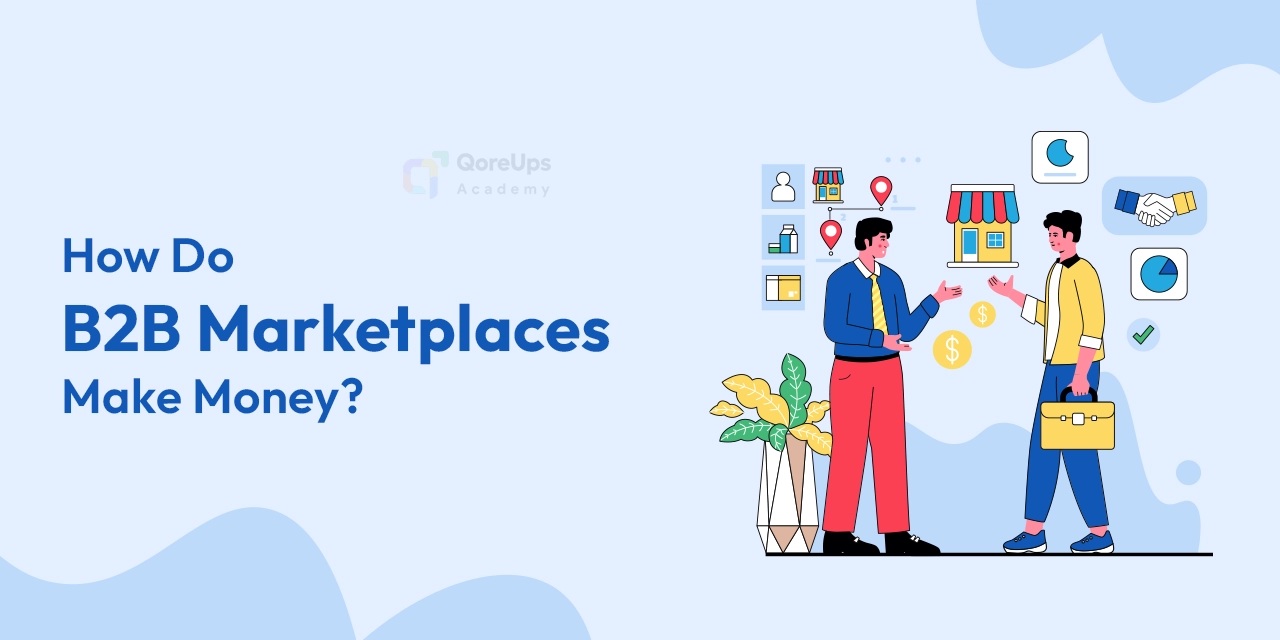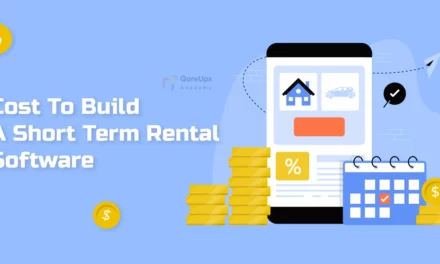In today’s business world, almost everything has gone digital.
Gone are the days of cold calls and catalog orders.
Now, companies connect, negotiate, and transact online through what we call B2B marketplaces.
The global business-to-business e-commerce market size is estimated to reach USD 58 billion by 2030
But here’s a question that comes up often:
“How do B2B marketplace platforms actually make money?”
After all, most of them don’t own any inventory, don’t ship products themselves, and often operate in the background.
So where does the profit come from?
Let’s talk about it.
Key Takeaways
- B2B marketplaces connect businesses, making trade easier and faster.
- Main revenue comes from commissions, subscriptions, listings, and leads, often combined for stable growth.
- Extra services like advertisements, payments/escrow services, logistics support, and data insights help marketplaces earn more while keeping users engaged.
- Challenges include trust, complex deals, off-platform transactions, and high user acquisition costs.
- For buyers: convenience and trusted connections; for sellers: wider reach and more sales; for the platform: a scalable, sustainable business.
First Things First: What Is a B2B Marketplace?
A B2B (business-to-business) marketplace is an online platform where businesses buy from and sell to other businesses.
Think of it like an Amazon, but specifically designed for bulk orders, wholesale pricing, and longer-term contracts.
These platforms aren’t just websites; they’re digital marketplaces built to simplify trade between suppliers, manufacturers, distributors, and retailers.
Some well-known examples of B2B Marketplaces include:
- Alibaba (global supplier-buyer network)
- IndiaMART (India’s largest B2B platform)
- Faire (focused on retailers and indie brands)
👉 B2B e-commerce sales are several times larger than B2C (business-to-consumer). In the U.S. alone, B2B digital sales surpassed $2 trillion in recent years, and they’re still growing.
💡 Want to learn how to come up with the right concept before you start building your platform?
Read this guide: 👉 How To Get The Best Ideas For An Online B2B Marketplace?
| B2B Marketplace | B2C Marketplace |
| Businesses sell to other businesses | Businesses sell to regular people |
| Deals are often big and take time | Deals are usually small and quick |
| Examples: Alibaba, IndiaMART | Examples: Amazon, eBay |
Core Revenue Models for B2B Marketplaces
Let’s get into the heart of it — how do these platforms actually turn a profit?
Most B2B marketplace platforms don’t rely on just one approach. Instead, they combine several core revenue streams. Each model taps into a different value the marketplace delivers — from connecting buyers and sellers, to building trust, to offering growth opportunities.
These are the primary ways B2B marketplaces generate income:
1. Transaction Commissions
This is the most common and widely accepted monetization method for B2B marketplaces. The platform takes a percentage or a flat fee from each successful transaction between buyer and supplier.
How does it work?
- A buyer places an order via the marketplace.
- The seller fulfills it, and once payment is processed, the marketplace deducts its commission before transferring funds to the seller.
Example
- If a company buys $5,000 worth of office furniture, and the platform charges a 5% commission, the marketplace earns $250 from that single deal.
- Platforms like Alibaba.com (in some categories) and Upwork follow this model.
Advantages
- Performance-based: the platform earns only when real value (a transaction) is created.
- Scales naturally: as sales volume grows, so does revenue.
- Low barrier to entry for sellers (no upfront costs to list products).
Challenges
- B2B deals are often large-ticket, and businesses may try to bypass the platform to avoid fees.
- Complex payment terms (credit, installments, net-30/60) can complicate commission collection.
Works Best When
- The marketplace facilitates high trust between buyers and sellers.
- It adds value in payments, logistics, or dispute resolution, making buyers and sellers less likely to skip the platform and deal directly.
2. Subscription Fees
Instead of charging per transaction, the marketplace offers tiered membership packages for suppliers. Sellers pay monthly, quarterly, or annually for access to premium features.
How does it work?
- Basic/free tier: limited listings or visibility.
- Paid tiers: priority search ranking, unlimited listings, analytics dashboards, direct buyer access, or marketing tools.
Example
- IndiaMART charges suppliers annual subscription fees for premium visibility and verified status.
- ThomasNet offers paid memberships that allow manufacturers to showcase certifications and detailed product catalogs.
Advantages
- Predictable recurring revenue, which investors love.
- Encourages long-term seller commitment.
- Easy to forecast and scale business operations.
Challenges
- Requires a strong value proposition to convince suppliers to pay upfront.
- If the marketplace has low buyer activity, sellers may not renew subscriptions.
- Harder to attract new sellers if competitors offer free entry.
Works Best When
- The marketplace has established traffic and credibility.
- Sellers see clear ROI from paid features (leads, branding, visibility).
3. Listing Fees
Sellers pay a fixed amount to list products, services, or company profiles on the platform.
How does it work?
- Fee can be per product, per category, or per listing duration (e.g., $10 per product per month).
- Works similarly to classified ads — the seller pays for exposure regardless of whether the sale happens.
Example
- Made-in-China.com offers paid product listing packages.
- Yellow Pages B2B directories also rely heavily on listing fees.
Advantages
- Simple and easy to implement.
- Immediate revenue — no need to wait for transactions.
- Useful for niche B2B markets where product visibility matters more than transaction facilitation.
Challenges
- Not performance-based — sellers may be reluctant if they don’t see enough leads.
- Risk of churn if sellers feel they’re paying “just for being listed.”
Works Best When
- Marketplace serves a niche vertical with limited competition.
- Buyers actively browse listings to find suppliers (e.g., specialty machinery, raw materials).
4. Lead Generation Charges
Instead of charging a fee for listings or sales, the platform earns by selling real buyer contacts to suppliers.
How does it work?
- Buyer submits an inquiry or RFQ (Request for Quotation).
- The platform validates it (to avoid spam).
- Multiple suppliers can bid for the lead, each paying a fee to access buyer details.
Example
- Alibaba.com charges suppliers for lead access via its RFQ marketplace.
- Thumbtack (B2C but similar model) charges professionals per lead instead of per transaction.
Advantages
- High ROI for suppliers — they pay only for qualified leads.
- Buyers get faster responses since suppliers are motivated to convert.
- Works well in industries where each lead is highly valuable (manufacturing contracts, bulk orders).
Challenges
- Lead quality must be consistently high — poor or duplicate leads will erode trust.
- Requires strong verification systems to avoid fake or low-intent inquiries.
- Some suppliers may hesitate if leads don’t convert into actual deals.
Works Best When
- The industry has long sales cycles and high-value contracts.
- Sellers value access to decision-makers more than simple visibility.
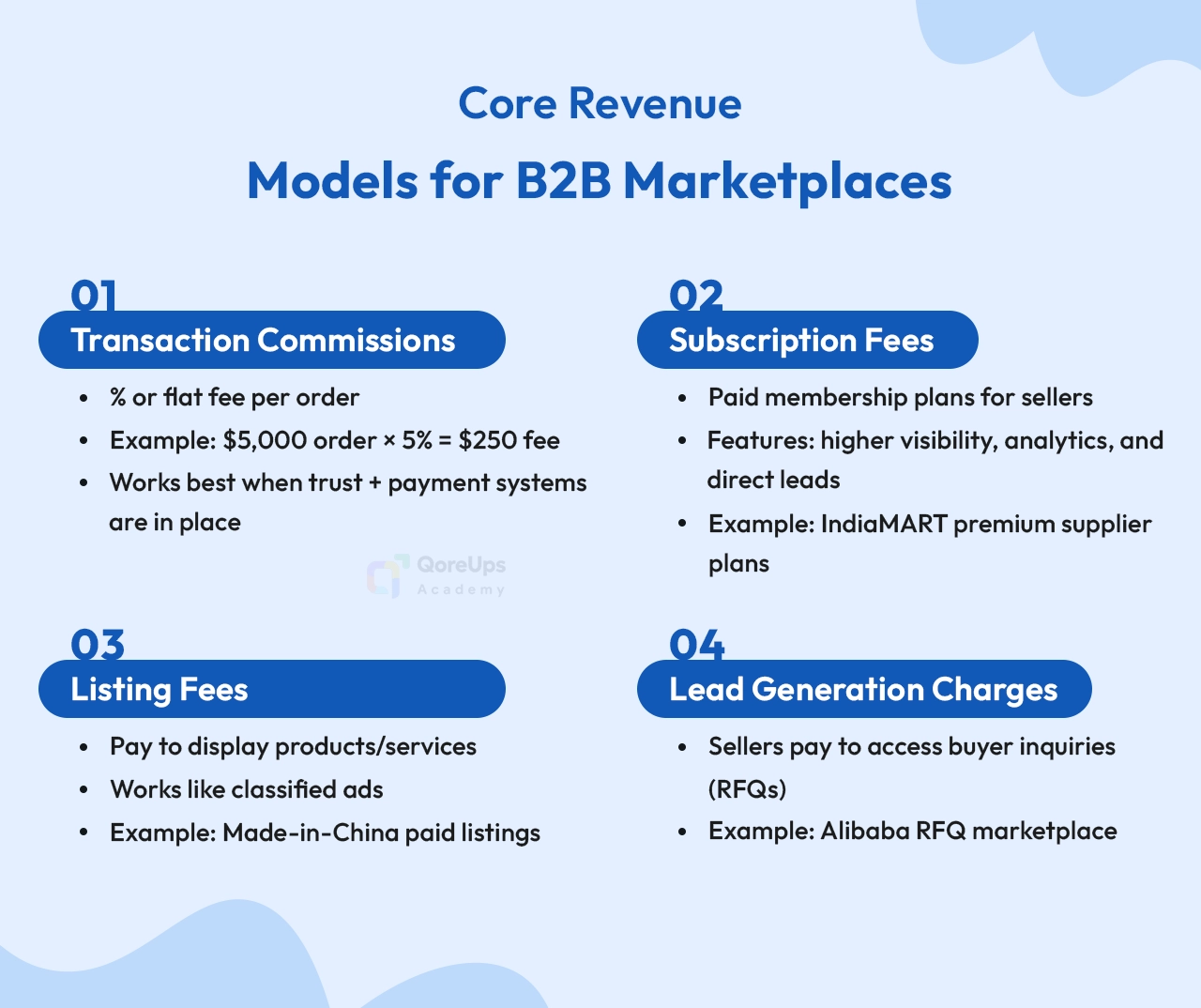
Pro Tip for Marketplace Owners:
Most successful B2B marketplaces don’t rely on just one monetization model. They combine multiple streams — for example, offering free listings, charging subscription fees for premium features, and taking a small commission on transactions. By diversifying revenue streams, the platform isn’t dependent on a single source of income and can unlock more growth opportunities.
| Way They Make Money | What It Means | Who Pays? | Why It Works |
| Commission | Commission from each order placed | Sellers (sometimes buyers) | The marketplace earns when sales happen |
| Subscription Fee | Regular fee for extra features | Sellers or buyers | Steady income for the platform |
| Listing Fee | Fee to put products or services on the site | Sellers | Keeps listings serious and quality high |
| Lead Fee | Charge for buyer contacts | Sellers | Sellers pay only if they get good leads |
If you’re planning to start a B2B Marketplace soon, you might want to understand its long-term benefits first.
Check this out: 👉 Starting An Online B2B Marketplace Platform: Top 7 Advantages
Additional Ways B2B Marketplaces Use to Earn More
Beyond the core models like commissions, subscriptions, and lead charges, successful B2B marketplaces often tap into complementary revenue streams. These not only increase profitability but also make the platform more valuable for users.
Here are some of the most lucrative additional monetization methods:
A. Advertising & Sponsored Listings
Visibility is everything in competitive markets. To help sellers stand out, marketplaces offer paid promotional slots — like sponsored product listings, homepage banners, or email newsletter features.
- How it works: Sellers bid or pay directly to have their products shown at the top of search results, similar to Google Ads or Amazon Sponsored Products.
- Why it’s valuable: Sellers gain more exposure and higher chances of winning deals, while the marketplace earns recurring ad revenue.
- Example: On Alibaba, suppliers can purchase “Gold Supplier” memberships and also invest in keyword bidding ads to rank above competitors.
B. Payment & Escrow Services
Trust and security are major concerns in B2B transactions, especially when dealing across borders. Marketplaces often step in by providing built-in payment gateways, escrow accounts, or buy-now-pay-later (BNPL) financing.
- How it works: Buyers pay through the platform; funds are held securely until the order is confirmed, and the marketplace takes a processing fee (usually 1–5%).
- Why it’s valuable: Ensures secure payments, reduces fraud risk, and keeps transactions within the platform.
- Bonus benefit: It prevents buyers and sellers from bypassing the platform since the secure payment channel is part of the value.
- Example: Upwork Escrow guarantees freelancers get paid and clients get the work delivered, while taking a service fee in return.
C. Logistics & Fulfillment Services
Shipping and cross-border logistics are often the most complex parts of B2B trade. To simplify this, many marketplaces now provide end-to-end logistics support — from warehousing to last-mile delivery.
- How it works: Sellers can store, package, and ship their products through marketplace-owned or partnered networks, paying fees for each service.
- Why it’s valuable: Sellers can focus on sales instead of shipping, while buyers benefit from consistent and trackable deliveries.
- Example: Alibaba’s “Cainiao Network” handles international shipping, customs clearance, and delivery — making trade seamless while adding another income stream for Alibaba.
D. Data & Insights Tools
B2B marketplaces sit on a goldmine of data — product performance, buyer demand patterns, regional trends, pricing benchmarks, and more. By turning this data into actionable insights, platforms can monetize it in powerful ways.
- How it works: The marketplace turns its data into valuable trend reports and buyer insights that sellers can purchase separately or unlock through higher-tier subscriptions.
- Why it’s valuable: Suppliers gain access to information that helps them price competitively, forecast demand, and understand buyer behavior.
- Example: “Amazon Business Analytics” offers suppliers detailed reports on customer orders, repeat purchases, and sales performance.
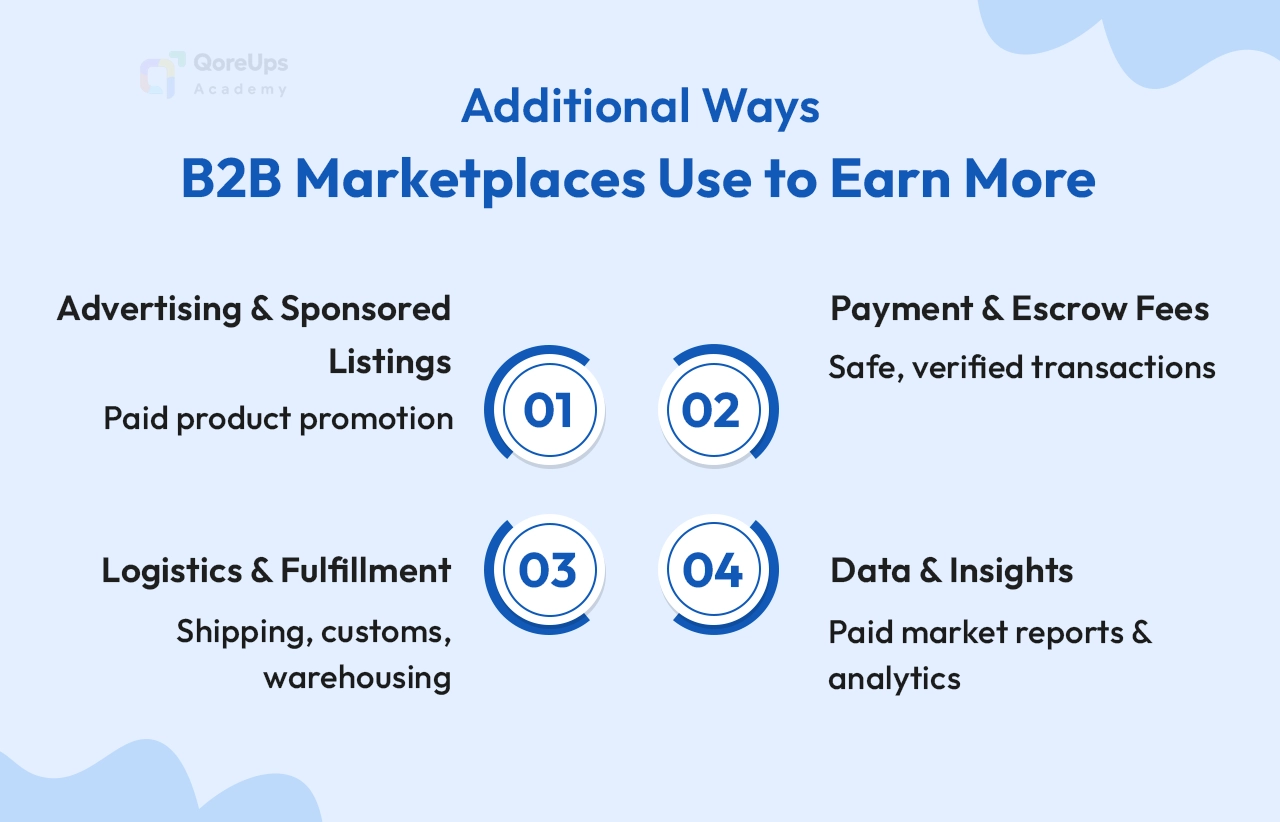
Takeaway
These additional monetization streams don’t just boost revenue — they increase stickiness by making the marketplace an essential partner in the seller’s business journey. From marketing and payments to logistics and insights, platforms that offer these services position themselves as one-stop solutions, making it harder for buyers and sellers to go elsewhere.
| Method | What It Is | Example | Why It Helps |
| Ads & Sponsored Listings | Sellers pay to appear at the top or in banners | Featured products, ads | Helps sellers get more attention |
| Payment Fees | Fees for handling safe payments | Payment gateways | Makes buying easier and secure |
| Shipping & Logistics | Helping with packing and delivery | Alibaba’s shipping network | Saves time and trouble for sellers/buyers |
| Data & Reports | Selling information about market trends | Analytics for sellers | Helps sellers make better choices |
Revenue Strategies of Global Leading B2B Marketplaces
To see how these models play out in practice, let’s look at how some of the most successful B2B platforms earn revenue:
Alibaba (A global B2B e-commerce marketplace)
- How Alibaba makes money: Alibaba charges suppliers for Gold Supplier memberships (a paid status that boosts trust and visibility). It also takes commissions on certain transactions and earns from advertising and logistics services like its Cainiao network.
- Why it works: Alibaba provides value far beyond simple listings — sellers get global reach, secure payments, and reliable logistics. That makes them willing to pay for multiple services.
IndiaMART (India’s largest online B2B marketplace)
- How IndiaMART makes money: IndiaMART focuses mainly on subscription plans for sellers, which give suppliers access to verified buyer leads and priority search rankings. It also earns from premium listings and ads.
- Why it works: Since IndiaMART is India’s largest B2B platform, suppliers see it as a must-have channel for reaching buyers. Paying for higher visibility translates into more deals.
Faire (A wholesale marketplace)
- How Faire makes money: Faire takes a commission from each supplier’s sale. It also offers value-added services like net-60 payment terms (buyers pay later, but sellers get paid quickly) and free returns for buyers, with the costs factored into seller fees.
- Why it works: By reducing friction for buyers (easy credit, hassle-free returns), Faire drives more purchases. Suppliers are happy to pay higher fees because the platform helps them win new customers at scale.
ThomasNet (An industrial sourcing and supplier discovery platform)
- How ThomasNet makes money: ThomasNet earns through lead generation fees, sponsored ads, and premium supplier profiles that showcase certifications, capabilities, and detailed catalogs.
- Why it works: ThomasNet positions itself as a trusted directory where serious buyers go for specialized industrial products. Suppliers pay because quality leads are worth far more than the fee.
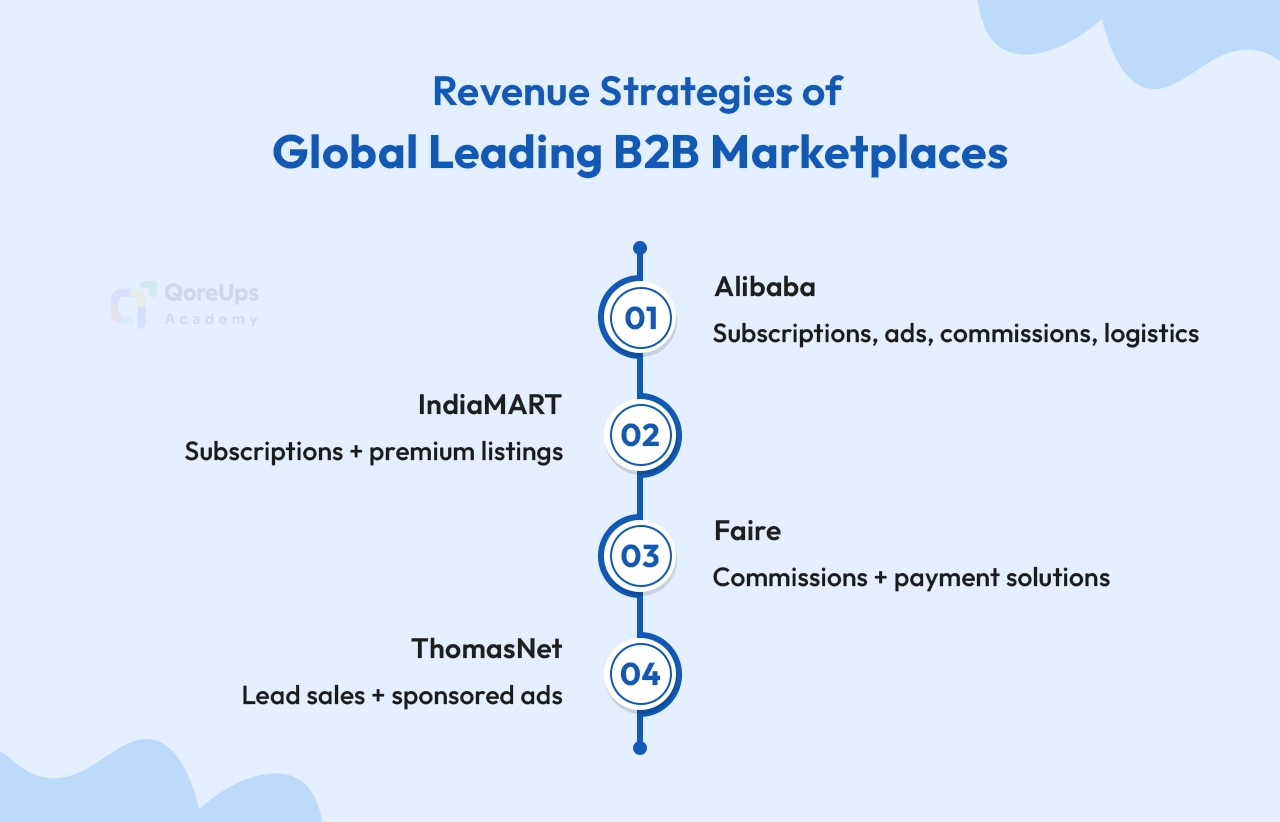
The Takeaway
Each of these platforms uses a slightly different mix of monetization models. Some rely heavily on subscriptions (IndiaMART), others on commissions and logistics (Alibaba, Faire), and others on lead generation and ads (ThomasNet). But the common thread is clear: they all add real value for both buyers and sellers — and then charge in smart, scalable ways for that value.
| Marketplace | How They Make Money | Special Features |
| Alibaba | Commissions, subscriptions, ads, shipping | Big global network with shipping help |
| IndiaMART | Subscriptions, premium listings | Focus on connecting buyers and sellers |
| Faire | Commissions, special payment services | Flexible payments, free returns |
| ThomasNet | Lead sales, ads, and premium profiles | Focus on industrial buyers and suppliers |
Why Monetizing a B2B Marketplace Isn’t Always Easy?
It’s not always easy to make a B2B marketplace profitable. There are some real challenges to keep in mind:
Trust & Verification
Businesses don’t hand over large payments lightly. Platforms need to check and verify suppliers and buyers, and have systems to handle disputes so everyone feels safe.
Complex Transactions
B2B deals are often more complicated than B2C. Think bulk orders, negotiated prices, credit terms, and shipping logistics — all of these make transactions tricky to manage.
Platform Leakage
Sometimes buyers and sellers meet on the platform but complete deals offline to avoid fees. This means the marketplace loses money. Preventing this requires smart incentives and platform design.
High Acquisition Costs
Bringing in quality buyers and reliable suppliers takes time, money, and a good reputation. It’s not cheap to grow a trusted network.
As one experienced marketplace founder said:
“Building a B2B marketplace is like running a trade show that never ends. You have to keep the booths full, attendees interested, and deals moving all the time.”
💡 Quick tip: The success of any B2B platform depends not only on its monetization strategy but also on the features it offers.
Discover the must-have functionalities every B2B marketplace should include:
👉 Top 10 Must-Have Features Of Online B2B Rental Marketplace
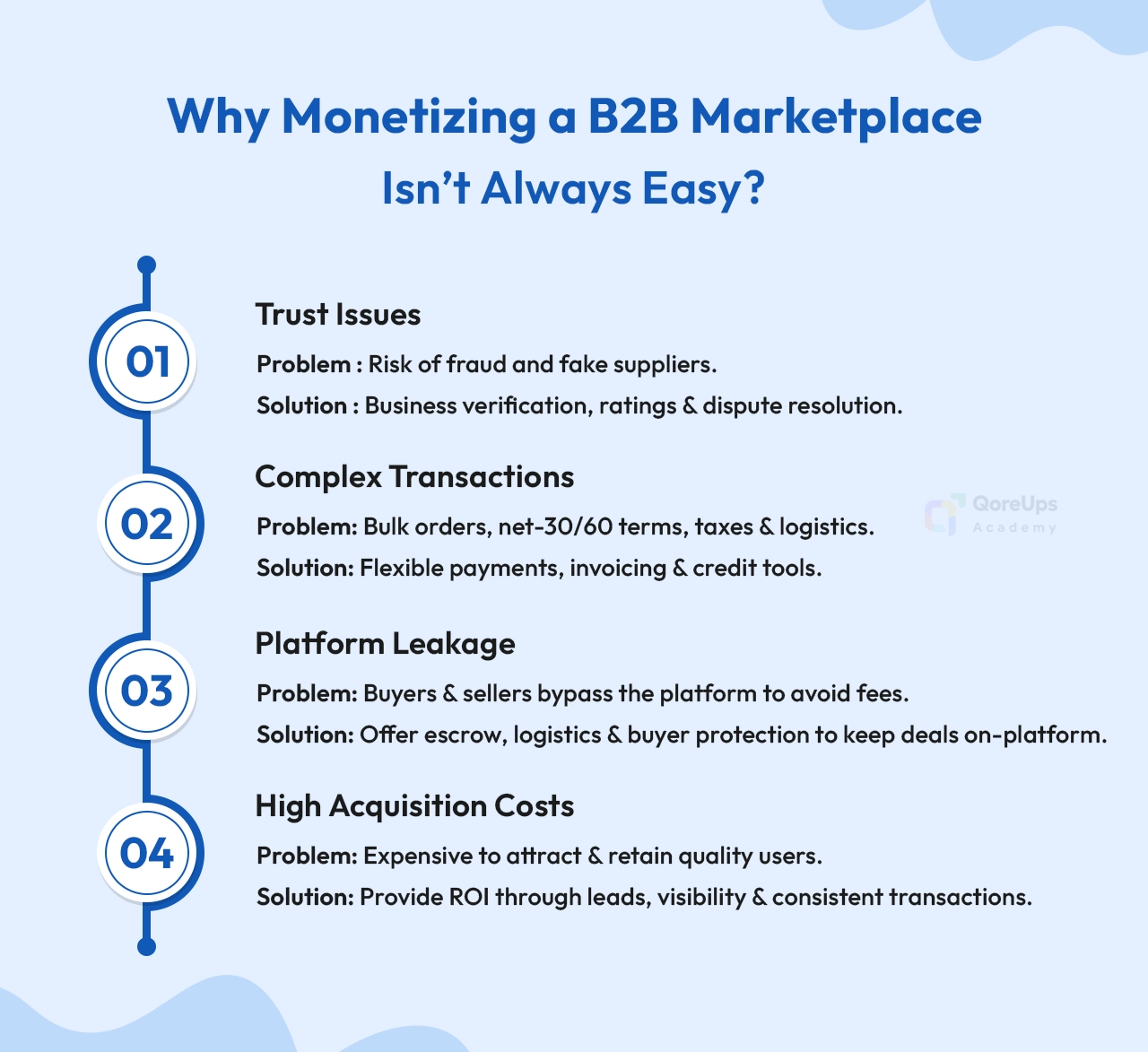
| Problem | Why It’s Hard | How to Fix It |
| Building Trust | Big money deals need verified businesses | Check sellers, solve disputes |
| Complex Deals | Bulk orders and payment terms are tricky | Make good tools for deals and payments |
| Off-Platform Deals | Users try to do business outside the marketplace | Encourage deals to stay on the platform |
| Getting Users | Finding good buyers and sellers costs time & money | Good marketing and reputation |
The Bottom Line on Monetizing B2B Platforms
At the core, B2B marketplaces make money by connecting businesses and facilitating value, then charging for that value in thoughtful ways.
Whether it’s commissions, subscriptions, advertising, or logistics, the best platforms find the right mix based on their audience and industry.
- For buyers, they offer convenience and trusted connections.
- For sellers, they offer a wider customer base and revenue.
And, finally, for the B2B marketplace platform, it’s a way to build a business that can grow and last.
As more industries move online, the opportunity to benefit from a digital marketplace is bigger than ever.

